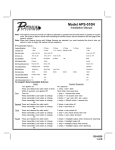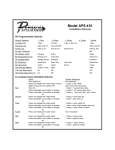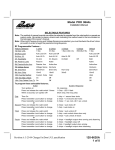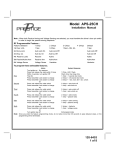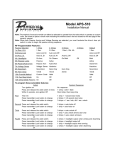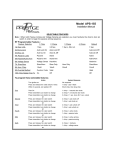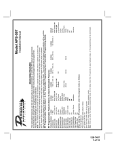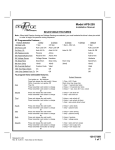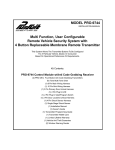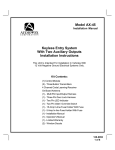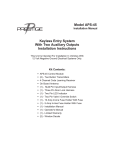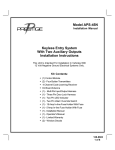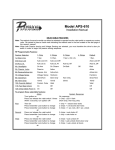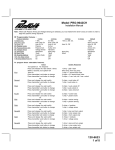Download Audiovox AX-500 Installation manual
Transcript
Model AX-500 Installation Manual Note: The method of manual override can either be selected to operate from the valet switch or operate as custom code. Be certain to place a check mark indicating the method used in the box located on the last page of the owner's manual. Note: When both Passive Arming and Voltage Sensing are selected, you must hardwire the driver’s door pin switch in order to begin the passive arming sequence. RF Programmable Features : Feature Selection 1st Door L/UL 1 Chirp 1 Sec. 2 Chirps 3.5 Sec. 3 Chirps 1 Sec L/Dbl. U/L 4 Chirps Default 350mSuL/1SL 1 Sec. 2nd Accy Lock Auto Lock On Auto Lock Off 3rd Accy. UL Auto UL Dr Auto UL All Auto UL Off 4th Headlights On Arm On Disarm On Both 5th Passive Locks Passive Active 6th Passive/Active Arm Passive Arm Active Arm 7th Voltage Sense Voltage Sense Hardwire 8th Siren/Horn Siren/Horn Siren Only Horn Only Siren/Horn 9th Horn Chirp 10mS 16mS 30mS 16mS Auto Lock Off Auto UL Off Off Both Active Active Arm Hardwire 10th Override Method Custom Code Valet Valet 11th Two Step Unlock On Off Off 12th Chirp Delete From Tx On Off Off To program these selectable features; Action Turn ignition on Press and release the valet switch 3 times Within 3 seconds, turn ignition Off First Then On Press transmitter Lock button to change Press transmitter Lock button to change or Second Press and release the valet switch Press transmitter Lock button to change or Third Press and release the valet switch Press transmitter Lock button to change Press transmitter Lock button to change or Fourth Press and release the valet switch Press transmitter Lock button to change Press transmitter Lock button to change Press transmitter Lock button to change or System Response No response 1 Chirp - LED 1 flash Short chirp, then long chirp 1 chirp = 1 second door locks 2 chirps = 3.5 second door locks 3 chirps = 1 sec. lock, dbl 1 sec. unlock 2 chirps = auto locks off 1 chirp = auto locks on 3 chirps = auto unlock off 1 chirp = auto unlock drivers door only 2 chirps = auto unlock all doors 3 4 1 2 chirps = headlight output when arming and disarming chirps = headlight output off chirp = headlight output when arming chirps = headlight output when disarming Revision A: 3-23-04 Changed 1st Door L/UL specification 128-6999A 1 of 8 Fifth Press and release the valet switch Press transmitter Lock button to change or Sixth Press and release the valet switch Press transmitter Lock button to change or Seventh Press and release the valet switch Press transmitter Lock button to change or Eighth Press and release the valet switch Press transmitter Lock button to change Press transmitter lock button to change or Ninth Press and release the valet switch Press transmitter Lock button to change Press transmitter Lock button to change or Tenth Press and release the valet switch Press transmitter Lock button to change or EleventhPress and release the valet switch Press transmitter Lock button to change or Twelfth Press and release the valet switch Press transmitter Lock button to change Press and release the valet switch or Turn ignition key off 2 chirps = active locks 1 chirp = passive locks 2 chirps = active arming 1 chirp = passive arming 2 chirps = hardwire 1 chirp = voltage sense 1 chirp = siren and horn output 2 chirps = siren output only 3 chirps = horn output only 2 chirps = horn chirp output 16mS 3 chirps = horn chirp output 30mS 1 chirp = horn chirp output 10 mS 2 chirps = valet switch override operation 1 chirp = custom code override operation 2 chirps = 2 step unlock off 1 chirp = 2 step unlock on 2 chirps = chirp delete from transmitter inactive 1 chirp = chirp delete from transmitter active Exit program mode Exit program mode Note: Once you enter the feature programming mode, do not allow more than 15 seconds to pass between steps, or the programming will be terminated. INSTALLATION OF MAJOR COMPONENTS Note: This system allows the transmitter to be programmed for single button lock/unlock or separate button lock/unlock. The receiver is set up as follows: Channel #1 = Lock/Unlock/Unlock 2 &Panic Channel #2 = If Programmed, Unlock/Unlock 2 & Panic Channel #3 = Channel 3 & Alternate Channel 3 Channel #4 = Channel 4 Output Channel #5 = Channel 5 Output (If so Equipped) During the program routine, if a transmitter button is programmed into receiver channel 2, then the unit will always have separate lock/unlock from that transmitter. If during the program sequence receiver channel 1 is programmed, and received channel 2 is skipped over, as indicated in the transmitted program guide, then the unit will operate as a single button lock/unlock unit from that transmitter. It is possible to have one transmitter programmed for single button lock/unlock, and one transmitter programmed for separate button lock/unlock if the customer so desires. If you inadvertently incorrectly program the transmitter, please read the information on re-prioritizing found in the transmitter programming guide. Control Module: Select a mounting location inside the passenger compartment ( up behind the dash ), and secure using the two screws provided. The control module can also be secured in place using cable ties. Do not mount the control module in the engine compartment, as it is not waterproof. You should also avoid mounting the unit directly onto factory installed electronic components. These components may cause RF interference, which can result in poor transmitter range or intermittent operation. Siren: Select a mounting location in the engine compartment that is well protected from access below the Page 2 128-6999A 2 of 8 vehicle. Avoid areas near high heat components or moving parts within the engine compartment. To prevent water retention, the flared end of the siren must be pointed downward when mounted. Mount the siren to the selected location using the screws and bracket provided. Hood or Trunk Pin Switch: A pin switch is included for use in protecting the hood or trunk ( or hatchback ) of the vehicle. The switch must always be mounted to a grounded, metal surface of the vehicle. It is important to select a location where water cannot flow or collect, and to avoid all drip gutters on hood and trunk fender walls. Choose locations that are protected by rubber gaskets when the hood or trunk lid is closed. The pin switch can be mounted using the bracket provided, or direct mounted by drilling a ¼ “ diameter mounting hole. Keep in mind that when properly mounted, the plunger of the pin switch should depress at least ¼ “ when the hood or trunk lid is closed. Dash Mounted L.E.D.: A small L.E.D. is included that will serve as a visual indicator of the alarm status. It should be installed in the dash, located where it can be easily seen from outside the vehicle, yet not be distracting to the driver. Once a location has been selected, check behind the panel for wire routing access, and to confirm the drill will not damage any existing components as it passes through the panel. Drill a ¼ “ diameter hole, and pass the red and blue wires from the L.E.D. through the hole, from the front of the panel. Firmly press the body of the L.E.D. into the hole until fully seated. Valet Switch: Select a mounting location for the switch that is easily accessible to the driver of the vehicle. The switch does not have to be concealed, however, concealing the switch is always recommended, as this provides an even higher level of security to the vehicle. The valet switch can be mounted to the lower side of the dash by drilling a ¼ “ diameter hole in the selected location. Be sure to check behind the dash for adequate clearance for the body of the switch, and to confirm that the drill will not damage any existing components as it passes through the dash. Route the two pin connector toward the control module. Shock Sensor: Select a solid mounting surface for the shock sensor on the firewall inside the passenger compartment, and mount the sensor using the two screws provided. The shock sensor can also be secured to any fixed brace behind the dash using tie straps. Whichever mounting method is selected, make certain that the sensitivity adjustment is accessible for use later in the installation. WIRING THE SYSTEM Large 8 Pin Edge Connector: Red/Purple (5Amp) & Red Fused (15Amp) Wires : + 12 VDC CONSTANT BATTERY SOURCE This wire controls the sensitivity of the voltage sensing circuit, which detects the turning on of an interior light when a door is opened. It will also detect the switching on of parking or headlamps, and in many cases will trigger the alarm when a thermostatically controlled electronic radiator cooling fan switches on. When installing this system into vehicles with electronic “ after fans “, it is recommended you disable the voltage sense circuit. In voltage sensing applications, the closer to the battery that the red wire is connected, the less sensitive the voltage sense circuitry will be. Moving this connection point to the fuse panel will increase the sensitivity, and connecting to the courtesy lamp fuse in the vehicle will provide maximum sensitivity of the voltage sense circuit. Be certain to set selectable feature # 7 to 1 chirp, Voltage Sense On. When hardwiring the control module to pin switches at all entry points, the voltage sense circuit must be disabled. Orange Wire: 300 mA GROUND OUTPUT WHEN ARMED - N. C. STARTER DISABLE This wire is provided to control the starter cut relay. Connect the orange wire to terminal 86 of the relay. Connect relay terminal 85 to an ignition wire in the vehicle that is live when the key is in the on and crank positions and off when the key is in the off position. (This is where the yellow wire from the alarm should be connected). Cut the low current starter solenoid wire in the vehicle, and connect one side of the cut wire to relay terminal 87A. Connect the other side of the cut wire to relay terminal 30. Note: This is a normally closed starter cut arrangement, and when power is removed from the security system, the starter disable feature will not operate, allowing the vehicle to start. Audiovox does not recommend using the Orange wire to interrupt anything but the starting circuit of the vehicle. Black w/ White trace Wire: Entry Illumination Ground Output This wire provides a 30 second ground output (300 mA Max) whenever the remote is used to disarm the alarm or to unlock the doors and provides a continuous pulsed output whenever the alarm is triggered. This wire should be connected to an external relay and wired to the vehicles interior entry lighting whenever the optional Interior Illumination circuit is desired. See Wiring Diagram for details. Page 3 128-6999A 3 of 8 Red/White Wire: DELAYED 300 mA PULSED OUTPUT / CHANNEL 2 This wire pulses to ground via an independent RF channel from the keychain transmitter. This is a transistorized, low current output, and should only be used to drive an external relay coil. WARNING: Connecting the white/blue wire to the high current switched output of trunk release circuits, some remote start trigger inputs, will damage the control module. Connect the white/blue wire to terminal 86 of the AS - 9256 relay (or equivalent 30 A automotive relay), and wire the remaining relay contacts to perform the selected function of channel 2. Brown Wire: POSITIVE OUTPUT TO SIREN Route this wire through a rubber grommet in the firewall, and to the siren location. Connect this wire to the positive wire of the siren. Secure the black ground wire of the siren to chassis ground. Black Wire: CHASSIS GROUND Connect this wire to a solid, metal part of the vehicle’s chassis. Do not confuse this wire with the thin black antenna wire that exits the control module independently. White Wire: + 12 VDC PULSED PARKING LIGHT OUTPUT (15 AMP MAX) This wire is provided to flash the vehicle’s parking lights. Connect the white wire to the positive side of one of the vehicle’s parking lights. Wiring The 11 Pin Mini Edge Connector: White/Blue Wire: 300MA PULSED OR LATCHING OUTPUT / CHANNEL 4 This wire latches to ground via an independent RF channel from the keychain transmitter. This is a transistorized, low current ( 300 mA ) output, and should only be used to drive an external relay coil. This wire provides an immediate ground signal, and stays at ground for as long as the button(s) on the keychain transmitter remains pressed. WARNING ! Connecting the purple/black wire to the high current switched output of trunk release circuits will damage the control module. Connect the purple/black wire to terminal 86 of the AS 9256 relay (or an equivalent 30 Amp automotive relay ), and wire the remaining relay contacts to perform the selected function of channel 4. White/Green Wire: Activation Output (Dbl. Push Required) This wire is controlled from the transmitter button programmed to the receiver's channel 2. By double pressing this the transmitter button, this output will become active for 1 second. This is a transistorized, low current (300 mA) output, designed to provide an output only when the transmitter is intentionally operated, such as is the case with remote start add on modules. If you require more than 300mA drive from this output, you must drive an external relay coil, and arrange the relays contacts to preform the specified function. NOTE: Pressing the transmitter button, then immediately pressing and holding it will cause this output to be active as long as the transmitter button is depressed. Brown/Black Wire: 300 mA Horn Output The brown/black wire is provided to beep the vehicle’s horn. This is a transistorized low current output, and should only be connected to the low current ground output from the vehicle’s horn switch. If the vehicle uses a + 12 VDC horn switch, then connect the black w/ white trace wire to terminal 86 of the AS 9256 relay ( or an equivalent 30 Amp automotive relay ), and connect relay terminal 85 to a fused + 12 VDC battery source. Connect relay terminal 87 to the vehicle’s horn switch output, and connect relay terminal 30 to a fused + 12 VDC battery source. Vacant Cavity In Connector: Not Used Blue Wire: ( - ) INSTANT TRIGGER ZONE This is an instant on ground trigger wire. It must be connected to the previously installed hood and trunk pin switches. Green Wire: - DOOR TRIGGER If the vehicle’s courtesy light switches have a ( - ) ground output when the door is opened (GM and most Imports), you must connect this wire to the negative output from one of the door switches. WARNING: Do not use the brown wire if the vehicle has + 12 volt output type door switches. (see Purple Wire). Note for vehicles with interior delay lighting see programming under title "Completing The Installation". Purple Wire: + DOOR TRIGGER If the vehicle’s door courtesy light switches have a + 12 volt output when the door is opened (most Fords and some Imports ), you must connect this wire to the positive output from one of the door switches. WARNING: Do not use the purple wire if the vehicle has ground output type door switches. ( see Brown Wire ). Note for vehicles with interior delay lighting see programming under title "Completing The Installation". Page 4 128-6999A 4 of 8 Yellow Wire: + 12 VDC IGNITION SOURCE Connect this wire to a source that is live when the key is in the on and crank positions. Be sure that this source is off when the key is in the off position. Green/Orange Wire: Low Current (-) Ground Headlight Output The green/orange wire is provided to operate the optional headlamp illumination feature of the system. This is a low current (300mA) output and must be connected to an external relay to control the high current switching circuit of the vehicle's headlamps. To use this option, Connect this wire to terminal # 86 of a P&B VF45F11 relay or equivalent. Connect Terminals #85 and # 30 to a fused + 12 Volts source with a current capability equal to or in excess of the factory headlamp fuse. Connect terminal # 87 of the relay to the switched + 12 volt wire feeding the vehicle's headlamp circuit. NOTE: For ground switched headlamp circuits, Connect the green/orange wire to terminal # 86 of a P&B VF45F11 relay or equivalent. Connect Terminal #85 to a fused + 12 Volts source. Connect terminal # 30 to a clean chassis ground. Connect terminal # 87 to the ground switched headlamp control wire in the vehicle. Blue/White Wire: (-) Instant Trigger Zone 1 This is a instant on ground trigger input intended for the connection of optional triggering devices. The ground trigger output wire of motion detectors, microwave detectors, or glass break detectors, can be connected to this trigger input wire. Purple/Black Wire: 300MA PULSED OR LATCHING OUTPUT / CHANNEL 5 The light blue/green wire pulses to ground via an independent RF channel from the keychain transmitter. This is a transistorized, low current output, and should only be used to drive an external relay coil. WARNING: Connecting the gray/black to the high current switched output of trunk release circuits, some remote start trigger inputs, will damage the control module. Connect the gray/black to terminal 86 of the AS - 9256 relay (or equivalent 30 A automotive relay), and wire the remaining relay contacts to perform the selected function of channel 5. 2 Pin White Connector: DASH MOUNTED L.E.D. Route the red and blue wires in the 2 pin white connector from the L.E.D. to the control module, and plug it into the mating white connector on the side of the module. 4 Pin White Connector: SHOCK SENSOR Route the red, black, blue, and green wires in the 4 pin white connector from the shock sensor to the control module, and plug one end into the shock sensor, and the other end into the mating white connector on the side of the module. Green, Blue, Blue/Red 3 Pin White Connector: Door Lock Outputs The Green and Blue wires will provide either a pulsed ground output to the factory door lock control relay, or a pulsed + 12 volt output to the factory door lock control relay. In either case, the maximum current draw through these outputs must not exceed 300 mA. The Blue/Red wire will provide a pulsed ground only, and will only provide an output when the unlock button of the transmitter is pressed a second time after a first unlock command was issued. This is used for second step unlock or all doors unlock in a two step circuit. In this arrangement, Green, or Blue is used to control the drivers door unlock relay, and the Blue/Red will be used to control unlock of all other doors. 3 Wire Ground Switched Single Step Door Locks In this application, the green wire provides a ground pulse during arming, or the pulsed ground lock output. Connect the green wire to the wire that provides a low current ground signal from the factory door lock switch to the factory door unlock control relay. The blue wire provides a ground pulse during disarming, or the pulsed ground unlock output. Connect the blue wire to the wire that provides a low current ground signal from the factory door unlock switch to the factory door unlock control relay. Red/Black Not Used. 3 Wire Ground Switched 2 Step Door Locks In this application, the green wire provides a ground pulse during arming, or the pulsed ground lock output. Connect the green wire to the wire that provides a low current ground signal from the factory door lock switch to the factory door lock control relay. The blue wire provides the first ground pulse during disarming, or the drivers door pulsed ground unlock output. Connect this wire to the drivers door unlock relay that requires a low current ground signal to unlock only the drivers door. If the vehicle does not have a sperate drivers door relay, one will have to be added. Locate the drivers door unlock motor wire and cut it at a convenient location to allow wiring of an optional relay. Connect the door side of the cut wire to terminal 30 of the optional relay added. Connect the vehicle side of the cut wire to terminal 87a of the optional relay added. Connect the blue wire of the 3 pin harness to terminal 86 of the optional relay added. Connect terminal 85 of the optional relay added to Page 5 128-6999A 5 of 8 a fused constant + 12 volt source. Most vehicles door lock/unlock motor legs rest at ground, and switch +12 volts to the door lock/unlock motor legs for operation, if this is the case in the vehicle you are working on, connect the remaining terminal, 87, to a fused + 12 volt source. In the rare instance that the vehicle door lock/unlock motor legs rest at + 12 volts and switches ground to the door lock/unlock motors, connect he remaining terminal, 87, to chassis ground. The Blue/Red wire provides a pulse ground output when the unlock button of the transmitter is pressed a second time after disarming. Connect the Blue/Red wire to the wire that provides a low current ground signal from the factory door unlock switch to the factory door lock control relay. 3 Wire Positive Switched Door Locks In this application, the green wire provides a positive pulse during disarming, or the pulsed + 12 volt unlock output. Connect the green wire to the wire that provides a low current positive signal from the factory door unlock switch to the factory door unlock control relay. The blue wire provides a positive pulse during arming, or the pulsed + 12 volt lock output. Connect the blue wire to the wire that provides a low current positive signal from the factory door lock switch to the factory door lock control relay. 3 Wire Positive Switched 2 Step Door Locks The blue wire provides a positive pulse during arming, or the pulsed + 12 volt lock output. Connect the blue wire to the wire that provides a low current positive signal from the factory door lock switch to the factory door lock control relay. The green wire provides a positive pulse during disarming, or the drivers door pulsed positive unlock output. Connect this wire to the drivers door unlock relay that requires a low current positive signal to unlock only the drivers door. If the vehicle does not have a separate drivers door relay, one will have to be added. Locate the drivers door unlock motor wire and cut it at a convenient location to allow wiring of an optional relay. Connect the door side of the cut wire to terminal 30 of the optional relay added. Connect the vehicle side of the cut wire to terminal 87a of the optional relay added. Connect the green wire of the 3 pin harness to terminal 86 of the optional relay added. Connect terminal 85 of the optional relay added to chassis ground. Most vehicles door lock/unlock motor legs rest at ground, and switch +12 volts to the door lock/unlock motor legs for operation, if this is the case in the vehicle you are working on, connect the remaining terminal, 87, to a fused + 12 volt source. In the rare instance that the vehicle door lock/unlock motor legs rest at + 12 volts and switches ground to the door lock/unlock motors, connect he remaining terminal, 87, to chassis ground. The Blue/Red wire provides a pulse ground output when the unlock button of the transmitter is pressed a second time after disarming. Because the vehicle you are working on requires a positive pulse from the factory door lock switch to the factory door lock control relay, you will have to add a relay to invert the output polarity of this wire. Connect the Blue/Red wire to terminal 86 of the optional added relay. Connect terminal 85 & 87 to a fuse + 12 volt source. Connect terminal 30 to the low current door unlock wire from the factory door switch to the door unlock control relay. Resistive Circuits, As Well As 4 Wire Polarity Reversal and 5 Wire Alternating 12 Volt Door Lock Control Circuits These applications require the use of additional components which may include relays, fixed resistors, or for convenience, the AS 9159 Door Lock Interface. Consult your technician or refer to the technical hotline provided by your sales representative for information on your particular vehicle for properly connecting to these types of circuits. 4 Pin Upgrade Telematic Module: Red = + 5 Volts Black = Ground White = Data TX Yellow = Data RX Connect the 4 pin harness found in the Telematic one way module kit to the mating port on the PTUGM. NOTE: If using the TWO WAY Telematic module, only Ground, TX, and RX are used on this port, the + 12 volt supply for the two way module must be sourced separately or the unit will not operate. COMPLETING THE INSTALLATION NOTE: This unit has the ability to learn the dome light delay time, up to 60 seconds. If the vehicle has delay interior lights, and you wish to avoid three chirp, defect zone, indication normally associated with this type of interior light, we suggest you learn the interior light delay. To learn the light delay, start with all doors closed: (1) Use the transmitter to Lock / Unlock / Lock / Unlock / Lock / Unlock / Lock, the system. The LED turns on solid to confirm the system entered the learn mode. (2) Immediately open and close the door of the vehicle to initiate the dome delay. The unit will monitor the door trigger input Positive, (Purple), and Negative, (Brown) when active. When the dome light turns off, the unit will add 2 seconds then exit the learn mode. (3) The LED will begin flashing the Armed indication indicating the unit has exited the learn mode and is armed. Page 6 128-6999A 6 of 8 Antenna Wire: Be sure to extend the thin black antenna wire to it’s full length, and cable tie into place where it cannot be damaged. Avoid wrapping this wire around major, high current wire looms. Adjusting the Shock Sensor: If used, the sensitivity of the pre - detect circuit is automatically set 30% less sensitive than the full trigger circuit. Using a small screwdriver, gently turn the adjustment screw fully counterclockwise. (DO NOT over turn this screw. Maximum rotation for this adjustment is 270°). Close the hood and trunk lids, and arm the alarm. Wait 6 seconds for the accessories trigger zone to stabilize, then firmly strike the rear bumper with the side of a closed fist considering the amount of force required to break a window. CAUTION: Never perform this test on the vehicle’s glass, as you may break the window. Turn the adjustment screw clockwise (increasing sensitivity) about ¼ turn and re-test. Repeat this procedure until the alarm sounds. Ultimately, one firm strike to the rear bumper will cause the alarm to emit pre-detect warning tones. WARNING ! Setting the sensitivity too high can cause false alarms due to noise vibrations from passing trucks and heavy equipment. To decrease sensitivity, turn the adjustment screw counter clockwise. Wire Dressing: Always wrap the alarm wires in convoluted tubing, or with a spiral wrap of electrical tape. Secure these looms along the routing using cable ties. This will ensure that the alarm wires are not damaged by falling onto hot or sharp moving surfaces in the vehicle. Operation: Take a few moments to check off the appropriate option boxes in the owner’s manual, and to fully explain the operation of the system to your customer. Place the Valet Switch Tag and or the Remote Start Control Switch Tag on their respective switches and point these out to the customer. 11 Pin Harness White/Blue White/Green Brown/Black Vacant Blue Green Purple Yellow Green/Orange Blue/White Purple/Black (-) Channel 4 Output Pulsed or Latched 300mA (-) Activation Output (Output With Double Push Of Trunk Pop Button) 300mA (-) Horn Honk Output 300mA No Connection (-) Trunk Pin Instant Trigger Input (Shunted During Trunk Pop) (-) Door Trigger Input (+) Door Trigger Input (+) 12V Ignition Input (-) Headlight Control Output 300mA (-) Negative Instant Trigger Input (-) Channel 5 Output Pulsed 300mA Red/Purple Orange Black/White Red/White Brown Black White Red 8 Pin Harness (+) 12 V Constant Power 5A (-) Starter Disable Output / Ground when Armed Output 300mA (-) Domelight Supervision Output 300mA (-) Trunk Pop Output Pulsed 300mA (+) Siren Output (-) Chassis Ground (+) 12 V Parking Light Output (+) 12 V Constant Power Input 15A Green Blue Blue/Red 3 Pin Lock Harness (+) Unlock / (-) Lock 300mA max (+) Lock / (-) Unlock 300mA max (-) 2nd Unlock 300mA max 4 Pin Telematic Harness White Data Transmit Yellow Data Receive Black Ground Red (+) 5 V 4 Pin Shock Sensor Harness Red (+) 12 Volt Constant Black (-) Ground When Armed Green (-) Full Alarm Trigger Input Blue (-) Warn Away Trigger Input Page 7 128-6999A 7 of 8 © 2003 Audiovox Electronic Corporation, 150 Marcus Blvd., Hauppauge, N.Y. 11788 128-6999A 128-6999A 8 of 8








